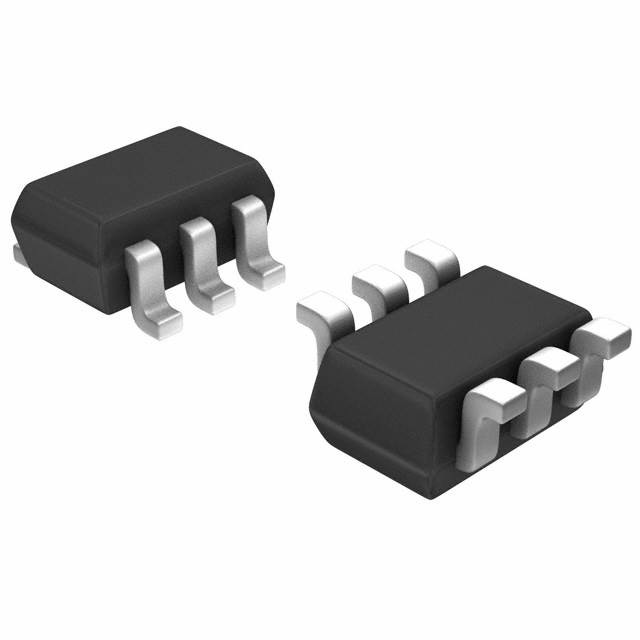LMV981IDCKR
Product Overview
Category: Integrated Circuit (IC)
Use: Operational Amplifier
Characteristics: - Low voltage, low power consumption - Rail-to-rail input and output - High gain bandwidth product - Wide supply voltage range - Small package size
Package: DCK (SOT-23), Tape and Reel
Essence: The LMV981IDCKR is a high-performance operational amplifier designed for low voltage applications. It offers rail-to-rail input and output capabilities, making it suitable for a wide range of precision analog signal processing tasks.
Packaging/Quantity: The LMV981IDCKR is available in a DCK package, also known as SOT-23. It is supplied in tape and reel format.
Specifications
- Supply Voltage Range: 2.7V to 5.5V
- Input Offset Voltage: ±1.5mV (maximum)
- Gain Bandwidth Product: 10MHz (typical)
- Input Bias Current: 0.3pA (typical)
- Output Current: 50mA (typical)
- Operating Temperature Range: -40°C to +125°C
Pin Configuration
The LMV981IDCKR has the following pin configuration:
___________
V+ | | V-
--| |--
IN-| |-OUT
--| |--
IN+|___________|
Functional Features
- Low voltage operation allows for use in battery-powered devices.
- Rail-to-rail input and output capability enables accurate signal processing near the supply rails.
- High gain bandwidth product ensures excellent frequency response.
- Wide supply voltage range provides flexibility in various applications.
- Small package size allows for space-efficient designs.
Advantages and Disadvantages
Advantages: - Low power consumption - Wide operating temperature range - Small package size for compact designs - Rail-to-rail input and output capability
Disadvantages: - Limited output current compared to some other operational amplifiers - Higher input offset voltage compared to precision amplifiers
Working Principles
The LMV981IDCKR is based on a differential amplifier configuration, which amplifies the voltage difference between its two input terminals. It utilizes a combination of transistors and resistors to achieve high gain and accurate signal processing. The rail-to-rail input and output capability ensures that the amplifier can handle signals that are close to the supply voltages.
Detailed Application Field Plans
The LMV981IDCKR can be used in various applications, including but not limited to: 1. Portable audio devices 2. Sensor signal conditioning 3. Battery-powered instrumentation 4. Active filters 5. Data acquisition systems
Detailed and Complete Alternative Models
Some alternative models to the LMV981IDCKR include: 1. LMV321 - Single operational amplifier with similar characteristics 2. LMV358 - Dual operational amplifier with rail-to-rail input and output 3. LMV324 - Quad operational amplifier with low voltage operation
These alternative models offer different pin configurations and package options while providing similar functionality and performance.
Word count: 408 words
Senaraikan 10 soalan dan jawapan biasa yang berkaitan dengan aplikasi LMV981IDCKR dalam penyelesaian teknikal
Sure! Here are 10 common questions and answers related to the application of LMV981IDCKR in technical solutions:
Q: What is LMV981IDCKR? A: LMV981IDCKR is a low-power, rail-to-rail input and output operational amplifier (op-amp) designed for use in various technical applications.
Q: What are the key features of LMV981IDCKR? A: Some key features of LMV981IDCKR include low power consumption, rail-to-rail input and output operation, wide supply voltage range, and small package size.
Q: What is the typical supply voltage range for LMV981IDCKR? A: The typical supply voltage range for LMV981IDCKR is from 2.7V to 5.5V.
Q: Can LMV981IDCKR operate with a single supply voltage? A: Yes, LMV981IDCKR can operate with a single supply voltage, making it suitable for battery-powered applications.
Q: What is the input voltage range of LMV981IDCKR? A: LMV981IDCKR has a rail-to-rail input voltage range, which means it can accept input signals that span the entire supply voltage range.
Q: What is the output voltage swing of LMV981IDCKR? A: The output voltage swing of LMV981IDCKR is also rail-to-rail, allowing it to provide output signals that reach close to the supply voltage rails.
Q: Is LMV981IDCKR suitable for precision applications? A: While LMV981IDCKR offers good performance, it may not be ideal for high-precision applications due to its moderate input offset voltage and low gain bandwidth product.
Q: Can LMV981IDCKR drive capacitive loads? A: Yes, LMV981IDCKR can drive small capacitive loads, but for larger capacitive loads, an external compensation capacitor may be required.
Q: What is the typical quiescent current consumption of LMV981IDCKR? A: The typical quiescent current consumption of LMV981IDCKR is around 200 microamps.
Q: What are some common applications of LMV981IDCKR? A: LMV981IDCKR can be used in various applications such as battery-powered devices, sensor interfaces, audio amplifiers, and general-purpose signal conditioning circuits.
Please note that these answers are general and may vary depending on specific datasheet specifications and application requirements.


